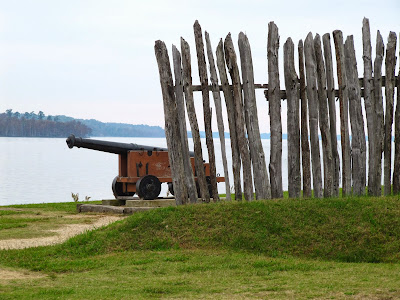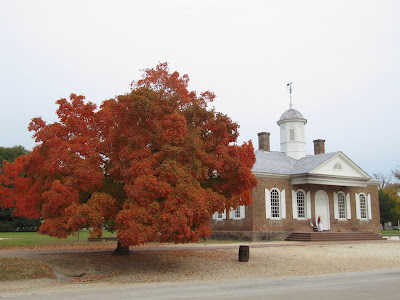JAMESTOWN, VIRGINIA
The site of Fort James and historic Jamestown was just another ruin from earlier times until Preservation Virginia was founded in 1889 in order to preserve some of Virginia's historic landmarks. In 1893, Preservation Virginia purchased 22.5 acres of land on Jamestown Island that included the site of the original Fort James that had been built in 1607 and the church tower. Between 1930 and 1934 the National Park Service acquired land to create Colonial National Historical Park which includes Jamestown and Yorktown and a parkway to connect the two sites with Colonial Williamsburg. Archaeological excavations began in 1994 and many sites have been identified. Many artifacts have been recovered and are displayed in the Voorhees Archaearium which is located at the park.
The first successful English settlement in North America was founded in 1607 in Jamestown, in the Colony of Virginia when 104 men and boys came ashore after anchoring their ships in the James River. Prior to the English colonists arrival, the Powatan Indians used this land for hunting, fishing and gathering food. Life was extremely difficult in those early days because of a long-lasting drought, a shortage of food and undrinkable water. By the end of winter of 1609-1610, of the 300 +/- colonists, only 60 had survived. In early summer, the survivors boarded ships intending to return to England but before they had gone far, they were met by ships that were bringing supplies and were ordered to return to Jamestown. The fort was restored and during ensuing years, conditions improved. More men and women arrived, their experimentation with planting tobacco proved profitable and so the colony grew. Jamestown's demise came in 1676 in what has become known as Bacon's Rebellion when Nathaniel Bacon, Jr. and a band of followers opposed Governor William Berkeley's policies for trading with Indians and other matters. Bacon occupied the town and before Governor Berkeley could reclaim it, Bacon burned the town down. There was an attempt to rebuild the city but it never fully recovered. After the statehouse burned a second time, in 1698, it was decided to move the capital inland, to Williamsburg.
Jamestown Memorial Church, constructed in 1907 to commemorate
the 300th anniversary of the settlement of Jamestown
Entry into Fort James
The Hunt Shrine, dedicated to the memory of the Rev. Robert Hunt (1568-1608),
the first Anglican minister of the colony.
Burial site of about 50 colonists who died the first summer, 1607. The colonists had been instructed by the Virginia Company in London to keep information about the number of sick and dying from the Indians so that the Indians would not know how vulnerable the colonists were. So the dead were buried inside the fort.
A reconstructed palisade marks the original site of Fort James
A "to scale" model of the original fort
Captain John Smith was born in England in 1580, to a tenant farmer. He joined the army at age 16 after his father's death. While in the army, he was captured and sold as a slave. He managed to escape his Turkish captors and eventually returned to England. In 1606, he was recruited to become part of the Jamestown Expedition. Although he only lived in the colony for a little over two years, he proved to be a strong leader. He believed that "he who shall not work, shall not eat" and so people worked. He learned the Powahatan language and maintained a peaceful relationship with them. Captain John Smith was elected governor in 1608 for a one-year term. In 1609 he returned to England, never to return to America.
Framework for a storehouse
Pocahontas, favorite daughter of Chief Powhatan, born around 1595. Her formal name was Matoaka. Pocahontas was a nickname that referred to her "frolicsome" nature. She was bright, lively and friendly and visited Fort James frequently. After Captain John left in 1609, relations between the Indians and Colonists deteriorated and Pocahontas no longer visited the fort. She was kidnapped by Captain Samuel Argall in 1613 who demanded the release of English prisoners, return of some stolen arms, and a supply of food, in return for Pocahontas's release. While she was a prisoner, she converted to Christianity, was baptized and took the name Rebecca. She also married John Rolf in April, 1614. In 1616, John Rolf, Pocahontas and their young son traveled to England. Shortly after setting sail in 1617 for their return to Virginia Pocahontas became ill and died, in March 1617. She was buried in England.
Interior of Jamestown Memorial Church
The 17th century church tower, the only original building standing above ground
This cross was erected in memory of the early settlers near another burial ground
Jamestown Tercentenary Monument, 103' tall - built to commemorate
the 300th anniversary of the founding of Jamestown
COLONIAL WILLIAMSBURG, VIRGINIA
In 1699, the capital of Virginia Colony was moved to Middle Plantation after Jamestown was burned to the ground during the Bacon Rebellion. Shortly after the move, the name of Middle Plantation was changed to Williamsburg. Williamsburg remained the capital until 1780 when, once again the capital was relocated, this time to Richmond. Many of the buildings were reconstructed on their original sites during the 1930's and made to look as original as possible. A number of the houses are now private residences so are not open to the public, but it's very interesting to wander the streets, with costumed docents walking around in period dress giving one a very civilized look at what life might have been like so many years ago.
Governor's Palace
Palace Green
Elkanah Deane house, now a private residence
George Wythe house, he was the first Virginian to sign the Declaration of Independence.
Steeple of Bruton Parish Church and beautiful fall colors
General George Washington sat here! Bruton Parish Church
Interior of Bruton Parish Church. George Washington's pew
was on the right.
Bruton Parish Church, built in 1715. The parish was established
in 1674 when two other parishes consolidated.
Merchant's Square, a modern shopping area adjacent to
Colonial Williamsburg
The Governor's Palace and the Palace Green as viewed from
Duke of Gloucester Street
Courthouse, constructed 1770-1771
Public Armory
Private residence
Capitol building
Let me out of here!!!
Solitude!























































